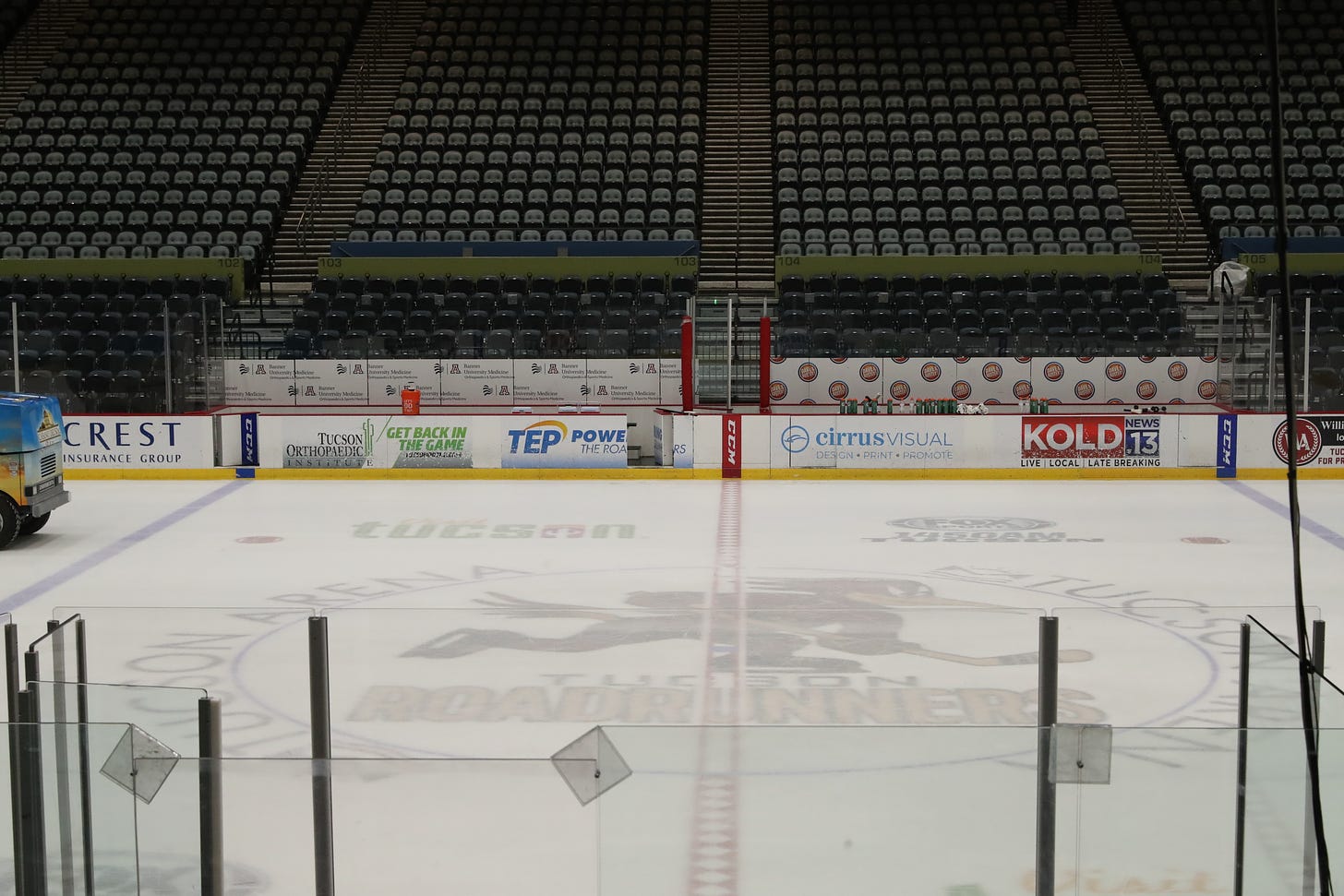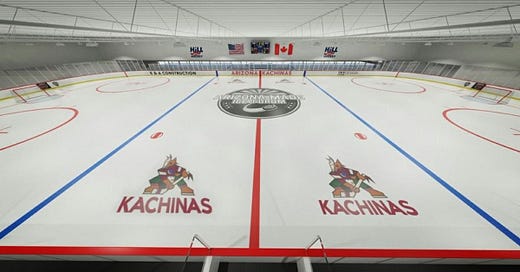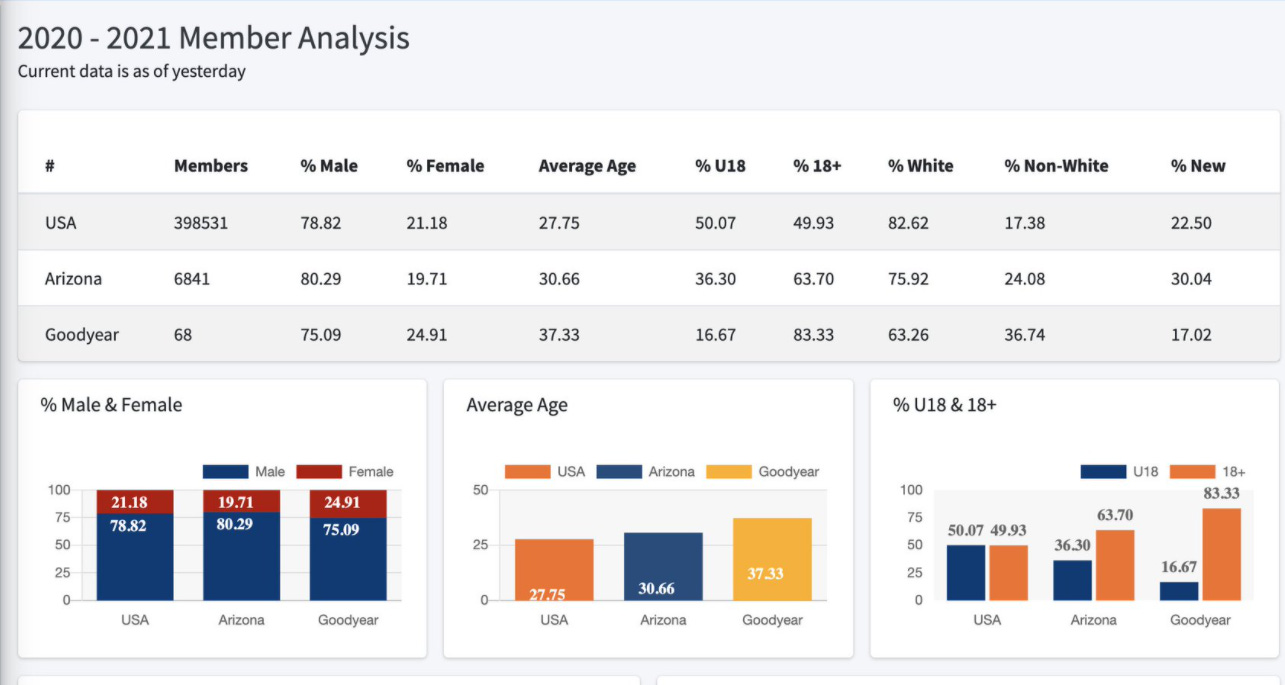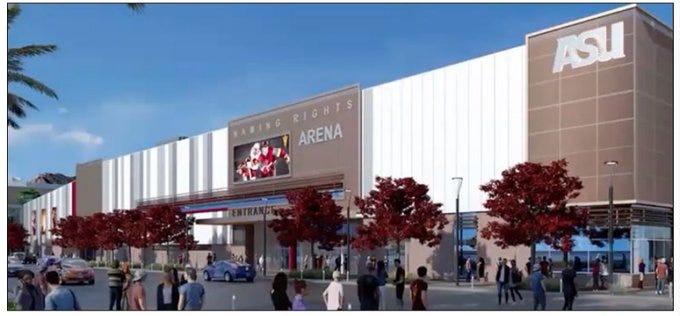The Big Read: If Coyotes want Arizona hockey to grow, more rinks are needed
USA Hockey data show state has fewest arenas, sheets per capita in nation
Welcome to the AZ Coyotes Insider newsletter. I generally publish stories four to six times per week (some of them free). By subscribing, you’ll be supporting independent, accountable journalism. Subscribe now so you won’t miss a story.

Editor’s note: This story was updated on Sunday afternoon with participation numbers from USA Hockey as of Nov. 7.
Arizona needs roughly twice as many sheets of ice as it has or has planned in the near future if it hopes to properly serve its hockey-playing public. That is the biggest takeaway from current data made available to AZ Coyotes Insider by USA Hockey.
The data are part of an initiative by the governing body for organized ice hockey in the United States to better serve its membership.
“We are a huge depository of information for the past 20 years,” said Doug Ticas, senior director of information technology for USA Hockey. “For the first 20 years, our data was just transactional. Now we can see the value in examining trends. By harnessing this information we are able to provide members with information that they’ve never had in the past.”
USA Hockey’s analytics system is available only to USA Hockey associations that are part of the Club Excellence System, but Ticas and USA Hockey’s director of software development, Cameron Eickmeyer (an ASU graduate), conducted a granular presentation for this story that demonstrated the value of their data.
The data are so precise that they can drill down into specific zip codes to identify growth patterns and participation numbers, as well as the age, gender and ethnic breakdowns of the membership within those zip codes.
“People want to know how to identify these areas where they should build rinks,” Ticas said. “Building a rink is a considerable investment so they want as much information as possible.
“We’re not investors in any of these projects. Our only intention is to continue to enhance the membership and the sport. We’re able to provide this information completely free of charge as long as you are a USA Hockey organization.”
In Arizona, there are currently 11 ice arenas and 16 sheets of ice with the recent opening of the Coyotes Community Ice Center in Mesa. Some of those sheets are not year-round, however, including ice in Tucson, Prescott Valley and at Glendale’s Gila River Arena where the Coyotes play and practice.
Developers broke ground in north Phoenix on the Legacy Sports Arena last year. The facility is scheduled to include two ice rinks but its completion date is unclear. Arizona State University’s new multi-purpose facility, scheduled to open in August 2022, will also include a practice sheet of ice intended for community use.
Current ice arenas (sheets) in Arizona
Ice Den Scottsdale (3)
Ice Den Chandler (2)
AZ Ice Peoria (2)
AZ Ice Gilbert (2)
AZ Ice Arcadia, Phoenix (1)
Coyotes Community Ice Center, Mesa (1)
Oceanside Ice Arena, Tempe (1)
Jay Lively Activity Center, Flagstaff (1)
Gila River Arena, Glendale (1)
Tucson Arena (1)
Findlay Toyota Center, Prescott Valley (1)
Per USA Hockey data and information provided by the U.S. Ice Rink Association, arenas need to sell at least 30 hours per week to remain viable. Coupled with rentals, birthday parties and other events that rinks typically host, they need about 200 players competing on an ice sheet to reach that threshold. Two hundred players equates to roughly 12 teams. Each team needs an hour per week minimum and most would have a practice and a game, putting that rink close to its hours threshold if it can book other events.
There are currently 7,607 USA Hockey registered players in Arizona. That means the state needs about 38 sheets of ice. If the Legacy project is completed and when ASU’s arena opens, Arizona would have at least 19 sheets of ice available to the public, but at the moment, Arizona’s players per arena (667.7) and players per ice sheet (489.7) are the highest in the nation. By comparison, Massachusetts has an arena for every 277.1 players and a sheet of ice for every 229.3 players. Minnesota has 105.9 players per arena and 97.7 per sheet. California has an arena for every 385.6 players and a sheet of ice for every 304.9 players. Florida has an arena for every 411.6 players and a sheet of ice for every 301.2 players.
Both Coyotes coach Rick Tocchet and GM Bill Armstrong agree that accessibility to ice is critical to sparking interest, particularly in a city where the sport is not as ingrained as it is in more traditional markets.
“When I was growing up outside Toronto, every town had its own rink,” Tocchet said. “I know this isn’t Canada, but if you look at some of the hockey hotbeds in the U.S., it’s the same thing in Chicago, Minnesota, Boston, Detroit. You’ve got to make it accessible to kids.”
When Armstrong made an appearance at the ribbon-cutting ceremony for the arena in Mesa (along with Coyotes director of external engagement for youth and women's hockey, Lyndsey Fry) he noted the impact that local arenas had on his childhood in Richmond Hill, Ontario.
“All of your culture was based around going to the rinks so rinks are special for me; they helped raise me as a kid,” he said. “Somebody in this neighborhood is going to become an NHL player simply by this ice sheet being created. There’s some family that will stroll in that are not hockey people and the next thing you know their kid just gravitates to it.”
With USA Hockey’s data, developers can pinpoint exactly where more arenas like Mesa’s should be built. There are obvious areas in the Valley and state.
City: USA Hockey members, rinks, ice sheets (2020-21 numbers are impacted by COVID-19)
Apache Junction: 20, 0, 0
Avondale: 28, 0, 0
Buckeye: 50, 0, 0
Casa Grande: 10, 0, 0
Chandler: 730, 1, 2
Flagstaff: 217, 1, 1
Gilbert: 875, 1, 2
*Glendale: 314, 0, 1
Goodyear: 72, 0,0
Laveen: 19, 0, 0
Litchfield Park: 55, 0, 0
Maricopa: 40, 0, 0
Mesa: 509, 1, 1
Paradise Valley: 60, 0, 0
Peoria: 468, 1, 2
Phoenix: 1,6583, 1, 1
*Prescott/Prescott Valley: 68, 1, 1
Queen Creek: 180, 0, 0
Scottsdale: 1,212, 1, 3
Surprise: 189, 0, 0
Tempe: 320, 1, 1
*Tucson: 89, 0, 1
* - The ice sheets in Tucson, Prescott and Glendale are not year-round

A glance at these numbers shows a definite need for a rink (and perhaps two ice sheets) in the Southwest Valley to serve communities such as Avondale, Buckeye, Goodyear, Laveen, Litchfield Park and Surprise, which combine for 413 members without even including nearby communities such as Tolleson or southwest Phoenix. The Southwest Valley does not have an arena. The nearest arenas are Gila River Arena (often unavailable) and Peoria.
Even with the Ice Den Scottsdale’s three sheets and perhaps the Legacy facility, the Northeast Valley could benefit from a few more sheets. The Chandler/Ahwatukee (the latter shows up as Phoenix) area could use more sheets, and the far Southeast Valley only has two sheets for 875 players from Gilbert, 180 from Queen Creek, 20 from Apache Junction and some of those 509 players from Mesa who live in the eastern part of the city.
Building arenas will be a major challenge for everyone as COVID-19 continues to ravage the economy, but when Coyotes president and CEO Xavier Gutierrez took his post in June, he immediately identified building more sheets of ice as a critical component in growing the game in Arizona. That includes Tucson, home of the Coyotes’ AHL affiliate. The Tucson Roadrunners play their games at Tucson Arena, but when their season ends, the ice is melted, leaving a greater metropolitan population of more than 1 million without a permanent sheet of ice.
“I went down there and I said, ‘’Let me get this straight. You have the University of Arizona, which has a really incredible club hockey program, and we’re the only professional sport in town with the Roadrunners but nobody has thought to put a permanent rink down here?” Gutierrez said. “I don’t know why the University of Arizona hasn’t done that as a community asset. That’s a nice little business that they could have created, but I am not privy to all of their concerns and constraints. The bottom line is that we should address that and we should work with the city. We’re going to create it. You should want your kids to stay in Tucson to play hockey, so let’s figure out how we do a public-private venture here.”

Tucson’s players often make the lengthy drive to Gilbert or Chandler to play their games. It’s not prohibitive for players who live on the northern end of the I-10 corridor, but USA Hockey data shows an enormous amount of growth in the southeast portion of Tucson as well, making a downtown location a logical spot to bring together all of Tucson’s 89 players; a number that does not even include surrounding areas such as Marana (6), Sahuarita (6) or other areas, and will likely rise considerably after COVID-19. Tucson had 483 members last year.
USA Hockey does not have access to city codes or available land within specific zip codes, but with its data, developers can make more informed decisions.
“This tool will be used in ways that USA Hockey cannot even imagine because of that,” Ticas said. “There was a member in Durham, North Carolina who used this tool to drill down and find an available lot in an area that needs an arena.”
While new construction is viable in some locations, Gutierrez sees more unconventional opportunities as well, including reimagined existing spaces like the rink in Mesa.
“There are plenty of big-box retailers that are no longer in existence so how do you reimagine that space?’ he said. “Let’s be creative. How do you utilize infrastructure, parking, buildings that are already up? Maybe there is an opportunity there. I don’t know but we are certainly going to pursue it. The solution isn’t always necessarily going to be to just throw up a rink. Maybe you reposition a real estate asset to become a rink.”
Clayton Keller remembers the impact that more arenas had on his hockey-playing career outside of St. Louis, where the Blues were about 35 years old when he began playing.
“The first rink I had when I grew up was five to 10 minutes from my house and that meant so much to me and my family,” he said. “Whether it was just dropping sticks and puck on the ice, playing, or all of the camps they had, it got me moving in the right direction.
“But at the time, there were not as many rinks as you would think and there were only a couple on the Illinois side where I grew up. The game has grown so much in St. Louis in the last few years and there are so many more rinks now. That has really helped turn St. Louis into a hockey market. That one year (2016), we had five guys drafted in the first round (of the NHL Draft) and that was really a big moment for the city.”
Ticas hopes more of USA Hockey’s membership takes advantage of the data now available.
“One of the challenges is we have 700,000 members and 3,000 associations so it’s tough getting information out there and making sure associations know this information is available,” he said. “We have multiple seasons going back over many years to examine trends and we are wondering what sort of markets will open up to us with this information.”
To join Club Excellence or if you have any questions, contact USA Hockey at (719) 538 1124 or ProgramServices@usahockey.org"
Follow Craig Morgan on Twitter: @CraigSMorgan







Spot on with the analysis, and as a Tucsonan it's especially important to find a way to get permanent ice with the Roadrunners being the only pro sports in town. I'm certain USA Hockey membership in the Tucson area will sky-rocket if anybody puts down some ice as there's not a whole lot of incentive to be a member or play hockey if there's no ice to play it on. With the number of transplants due to the weather and the Air Force base there's a huge population of people who would be happy to play hockey if they didn't have to drive to Chandler to do it. The city plopped down a tiny outdoor ice rink last December and the lines were hours long every single day just to get out on a sheet of ice a quarter of the size of a full size rink. I know for sure that the second a permanent sheet of ice goes down that my kids and I will be playing in hockey some measure.
Those member numbers really emphasize how terribly Gila River Arena is located in relation to most presumed Coyotes fans, let alone the general population.